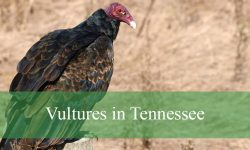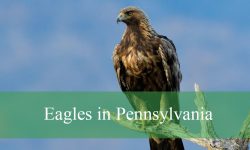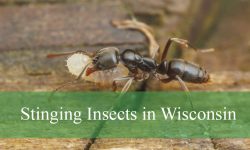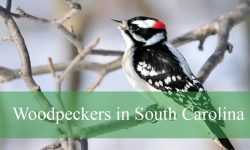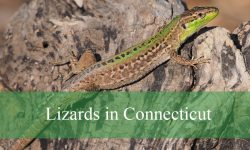Echoing across Utah’s canyons, forests, and deserts, the rhythmic drumming of woodpeckers is a sound that instantly connects you to the wild. From mountain spruce stands to desert scrub, these striking birds can be found in nearly every corner of the state, each with its own personality and behaviors to discover.
Watching a woodpecker in action is a fascinating experience. Some cling to pine trunks, chiseling deep for hidden insects, while others hover in open skies, catching prey mid-flight. Their bold patterns and distinctive calls make them some of the most exciting birds to observe, whether on a quiet forest trail or in your own backyard.
Utah hosts nine different species of woodpeckers, ranging from the tiny Downy Woodpecker to the striking Lewis’s Woodpecker. Learning how to identify them, where they live, and when they’re most active not only enhances birdwatching but also deepens appreciation for the state’s diverse habitats.
Types of Woodpeckers Found in Utah
Downy Woodpecker
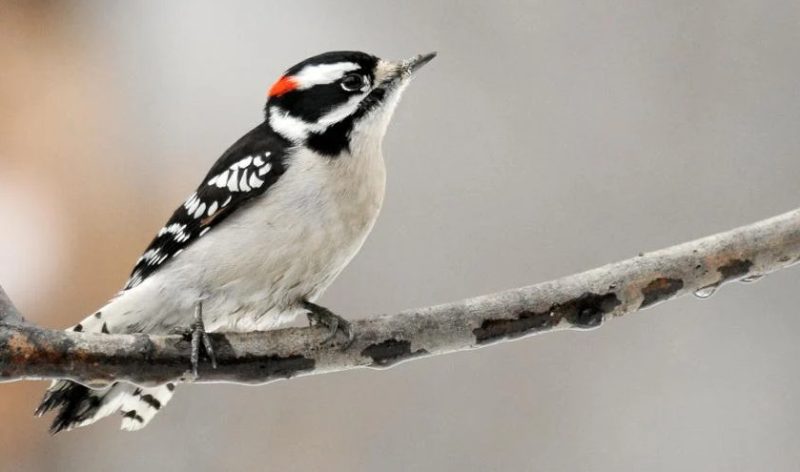
The Downy Woodpecker is the smallest woodpecker species in North America and a common resident of Utah’s forests, riparian zones, and even suburban neighborhoods. Measuring about 6 to 7 inches in length with a wingspan of 10 to 12 inches, it has a short bill that is proportionally smaller than most woodpeckers. Its plumage is marked by a striking black-and-white pattern, with a white back, black wings with white spots, and a crisp white belly. Males can be identified by a small red patch on the back of the head, which females lack.
When foraging, Downy Woodpeckers tap delicately on small branches, shrubs, and tree trunks, often inspecting twigs and stems where insects hide. Their diet consists largely of beetle larvae, ants, and caterpillars, but they also consume berries, seeds, and suet from backyard feeders. Unlike larger species, they are nimble and frequently cling to smaller branches, which makes them easy to spot hopping among shrubs.
Behaviorally, Downy Woodpeckers are relatively tame and adaptable. They are year-round residents in Utah and remain active even in winter, often joining mixed-species flocks with chickadees and nuthatches. This flocking behavior not only provides protection from predators but also improves their foraging success. Their drumming on hollow trees and metal poles in residential areas is a common sound during breeding season.
A fun fact about the Downy Woodpecker is that despite looking very similar to the Hairy Woodpecker, its bill is about one-third the size, giving it a more delicate appearance. Birdwatchers in Utah often use this bill size difference to separate the two species when seen side by side.
Hairy Woodpecker
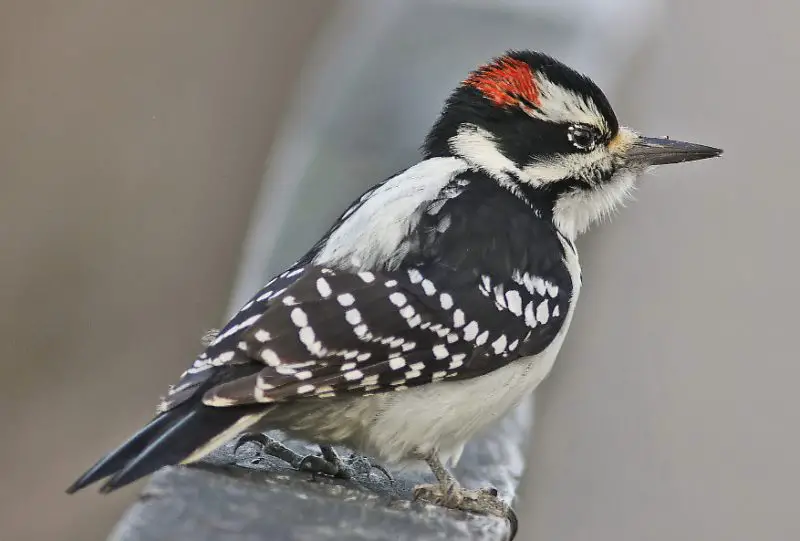
The Hairy Woodpecker is another widespread species across Utah, closely resembling the Downy Woodpecker but noticeably larger. Adults measure about 9 to 10 inches long with a wingspan of 13 to 16 inches. They have similar black-and-white plumage with a white back, white underparts, and spotted wings. Like the Downy, males have a red patch on the back of the head. The most reliable way to distinguish them is by their long, chisel-like bill, which is nearly the same length as their head.
This species feeds mainly on wood-boring insects, including beetle larvae, ants, and moth pupae. They are powerful excavators, often hammering deep into tree bark to expose hidden prey. In Utah, they thrive in mature forests of aspen, pine, and cottonwood, where dead or decaying trees are abundant. They also visit feeders for suet and occasionally consume fruits and seeds.
Hairy Woodpeckers are solitary or found in pairs during the breeding season, but in winter they may forage alongside mixed flocks of small birds. Their drumming is louder and more resonant than that of the Downy, making them easier to detect by sound. They also use their strong bills to create nesting cavities in standing dead trees, which later provide shelter for other bird species.
A fascinating fact about Hairy Woodpeckers is that they play a crucial ecological role as “forest doctors,” helping control insect outbreaks by consuming large numbers of wood-boring insects. In Utah’s forests, this service is especially important in keeping tree populations healthy.
Northern Flicker
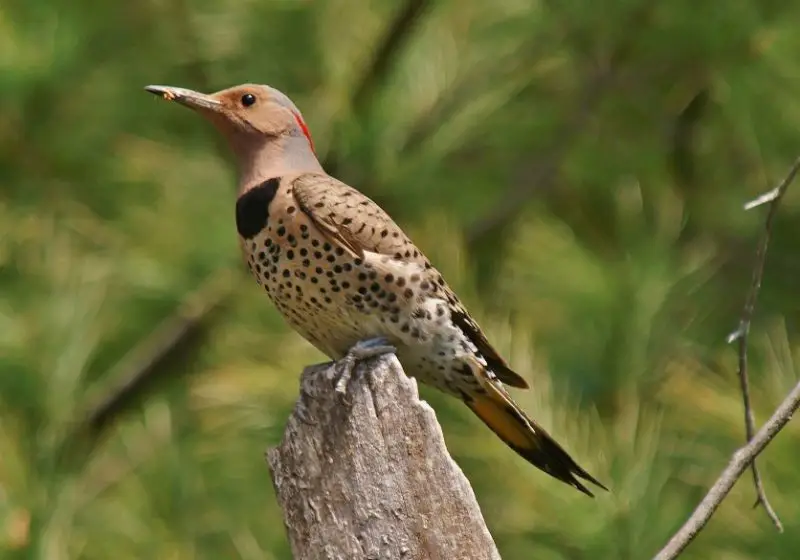
The Northern Flicker is one of the most distinctive woodpeckers in Utah, easily recognized by its large size and striking coloration. Measuring 11 to 12 inches in length with a wingspan of 16 to 20 inches, this species is primarily brown with black bars on the back and wings. Its most notable feature in Utah is the red crescent on the nape and a black “bib” on the chest. Unlike most woodpeckers, it spends a great deal of time foraging on the ground.
Northern Flickers specialize in eating ants, which make up the majority of their diet. They use their long, barbed tongues to lap up ants and beetles from soil and rotting logs. They also consume fruits, berries, and seeds, particularly in winter when insects are less available. In Utah’s open woodlands, grasslands, and even city parks, they are frequently seen walking or hopping across the ground, a behavior not common among other woodpeckers.
Behaviorally, Northern Flickers are highly vocal, producing a loud “wick-a-wick-a-wick” call that echoes across open landscapes. During courtship, they perform a “fencing” display, where two males face off, bobbing their heads and spreading their wings to attract females. They nest in cavities they excavate in dead trees, fence posts, or even abandoned buildings. In Utah, flickers are migratory, with some remaining year-round while others move south during colder months.
A fun fact about the Northern Flicker is that it is one of the few North American woodpeckers that regularly migrates. Birders in Utah often notice their arrival in spring, when flocks can be seen flying north, flashing their bright white rump patches.
Red-naped Sapsucker
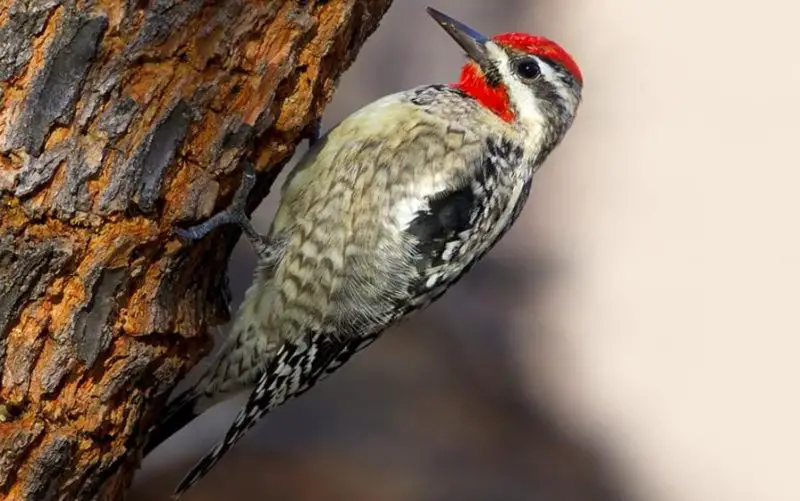
The Red-naped Sapsucker is a striking medium-sized woodpecker found in Utah’s mountain forests, riparian zones, and orchards. It measures 7 to 8 inches long with a wingspan of 14 to 16 inches. Its plumage features bold black-and-white striping with a white vertical bar on the wing. The most distinctive field marks are the red crown and throat, along with a black-and-white face pattern. Males have more extensive red on the throat compared to females.
As its name suggests, the Red-naped Sapsucker feeds primarily on tree sap. It drills neat rows of small holes, called sap wells, in tree bark, particularly in aspen, birch, and pine. These wells attract not only sap but also insects that the woodpecker eats. In addition, they consume fruits and berries, especially during fall migration. Their foraging behavior often benefits other animals, as hummingbirds and warblers frequently visit sap wells to feed.
This species is a migratory breeder in Utah, arriving in spring and departing for warmer regions in late fall. They are most commonly found in mid- to high-elevation forests, where they excavate nest cavities in aspens and cottonwoods. Their drumming is distinctive and irregular, sounding like a stutter rather than a steady rhythm, which helps differentiate them from other woodpeckers.
A fun fact about Red-naped Sapsuckers is that their sap wells act as miniature ecosystems, supporting a variety of insects, birds, and mammals. In Utah, hummingbirds often follow them closely in spring, timing their migration to coincide with the availability of sap.
Williamson’s Sapsucker
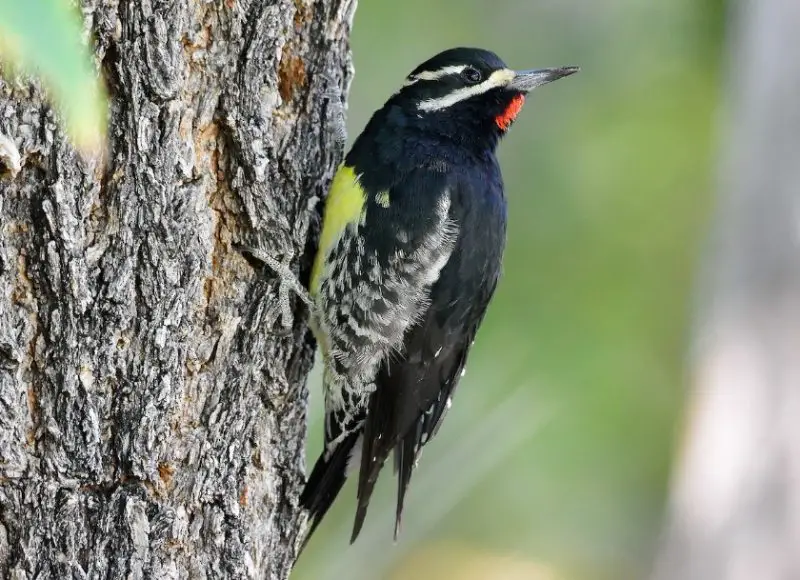
Williamson’s Sapsucker is one of the most striking and sexually dimorphic woodpeckers in Utah, meaning males and females look very different. Males are mostly black with a bold white wing patch and a red throat, while females are brown with heavy barring across the body and a yellow belly. Both sexes measure around 8 to 9 inches in length with a wingspan of about 16 inches. Their contrasting appearances can make them seem like two separate species to the untrained eye.
This species primarily feeds on tree sap, drilling rows of shallow holes in conifers and deciduous trees. They also eat ants, beetles, and other insects, particularly when feeding young in the nest. Fruits and berries supplement their diet in late summer and fall. In Utah, they are typically found in coniferous forests at mid to high elevations, especially in areas with a mix of pine and aspen.
Williamson’s Sapsuckers are migratory in Utah, breeding in the mountains during spring and summer and then moving southward for winter. They excavate nest cavities in dead or decaying trees, often reusing the same nesting sites year after year. Unlike some woodpeckers, they are relatively quiet, with softer drumming and fewer vocalizations, which makes them harder to detect.
A fun fact about Williamson’s Sapsucker is that it was once thought that the male and female were two different species because of their drastically different appearances. It wasn’t until the late 19th century that ornithologists realized they were the same bird.
Lewis’s Woodpecker
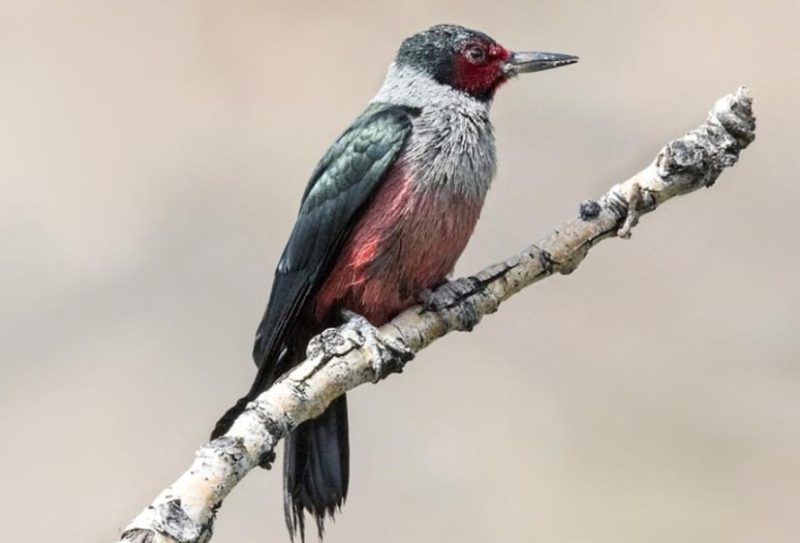
Lewis’s Woodpecker is one of the most unique woodpeckers in Utah, both in appearance and behavior. Measuring 10 to 11 inches long with a wingspan of about 19 to 20 inches, it is larger than many other species in the state. Unlike the typical black-and-white pattern of most woodpeckers, Lewis’s has dark greenish-black upperparts, a pinkish belly, and a striking red face. Its glossy plumage and unusual color combination make it stand out dramatically against Utah’s landscapes.
This species feeds differently from most woodpeckers. Instead of constant drilling, Lewis’s Woodpecker often catches insects in mid-air, much like a flycatcher. It also eats nuts, acorns, and berries, storing them in tree crevices for later use. In Utah, they are commonly seen in open pine forests, burned woodlands, and along river valleys where insect populations are abundant. Their graceful gliding flight, unlike the undulating flight of most woodpeckers, is another key identification trait.
Lewis’s Woodpeckers are cavity nesters, preferring dead or decaying trees for excavation. They are highly territorial during the breeding season and defend nesting sites aggressively. Their populations fluctuate depending on food availability, particularly acorn crops, which influence their distribution in Utah from year to year.
A fun fact about Lewis’s Woodpecker is that it was named after Meriwether Lewis of the Lewis and Clark Expedition, who first documented the species in the early 1800s. In Utah, spotting one feels like a step back into history, connecting birdwatchers to one of America’s earliest naturalists.
Black-backed Woodpecker

The Black-backed Woodpecker is a striking and specialized species, found in Utah’s burned conifer forests. Measuring 9 to 10 inches long with a wingspan of about 16 to 17 inches, it is easily identified by its sooty black back, white underparts, and bold facial markings. Males sport a bright yellow crown patch, which adds a splash of color to their otherwise dark appearance. Their black plumage provides excellent camouflage against the charred bark of burned trees.
This species is a burn-specialist, thriving in forests recently affected by wildfires. Their primary diet consists of wood-boring beetle larvae, which proliferate in dead and dying trees after a fire. Using their sharp bills, they flake off bark to reach hidden insects. Because of their dependence on fire-created habitats, their distribution in Utah is patchy, often appearing in an area only for a few years before moving on as the forest regenerates.
Black-backed Woodpeckers are solitary and relatively quiet compared to other woodpeckers. Their drumming is slower and more deliberate, used mainly for communication during breeding season. They excavate nesting cavities in fire-killed trees, which later serve as valuable nesting sites for other cavity-nesting birds. Their presence in a forest is often an indicator of healthy post-fire ecology.
A fun fact about this species is that its tongue can extend nearly two inches beyond its beak, coated with barbs and sticky saliva, allowing it to efficiently extract insect larvae from deep tunnels under bark. In Utah’s burned forests, this adaptation makes it an expert predator of beetles.
American Three-toed Woodpecker

The American Three-toed Woodpecker is a rare and specialized woodpecker that inhabits Utah’s high-elevation coniferous forests. Slightly smaller than the Black-backed Woodpecker, it measures 8.5 to 9 inches long with a wingspan of 15 to 16 inches. Its plumage is mostly black and white, with heavy barring on the back and wings. Males have a small yellow crown patch, while females do not. The species’ name comes from its unusual trait—having only three toes instead of the typical four found in most woodpeckers.
This adaptation may help the bird cling more firmly to tree trunks as it forages. Like the Black-backed Woodpecker, it specializes in feeding on bark beetle larvae and other insects found under tree bark. They are often seen scaling tree trunks, flaking off bark in search of hidden prey. Their diet also includes spiders and occasional fruits, but insects remain their primary food source.
In Utah, American Three-toed Woodpeckers are usually found in dense spruce, fir, and lodgepole pine forests, particularly in areas affected by insect outbreaks or fire. They are non-migratory and remain in these forests year-round, though their numbers are relatively low and they are considered an uncommon species in the state. Their drumming is slower and more irregular compared to other woodpeckers.
A fun fact about this species is that it is one of the few woodpeckers in North America with only three toes, a trait it shares with the Eurasian Three-toed Woodpecker. This makes it a fascinating example of evolutionary adaptation. In Utah, encountering one is considered a special event for birdwatchers due to its rarity.
Ladder-backed Woodpecker
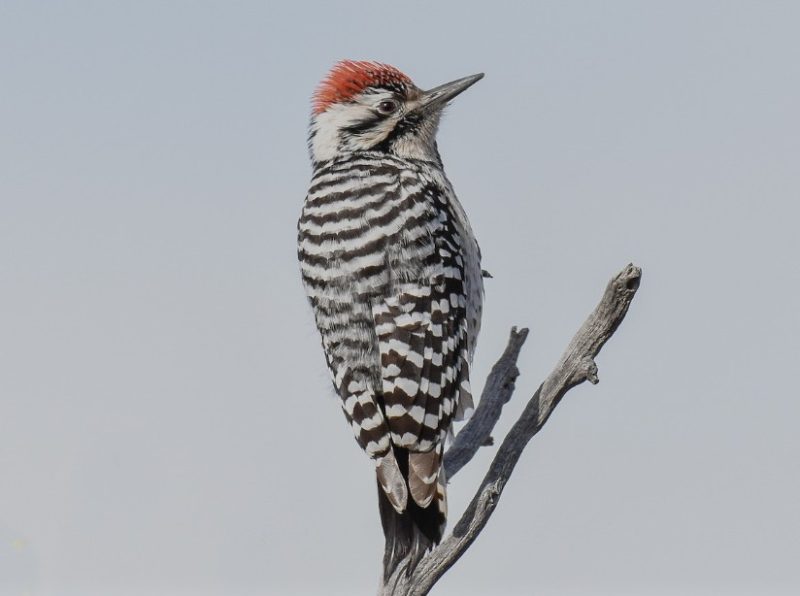
The Ladder-backed Woodpecker is a small but striking desert woodpecker found in southern Utah’s dry shrublands and canyonlands. Measuring about 7 to 8 inches long with a wingspan of 13 inches, it is easily identified by its black-and-white “ladder-like” pattern across the back and wings. The underparts are pale with faint barring, and males display a bright red crown patch, which is absent in females. Its small size and bold markings make it stand out in desert habitats.
This species is well adapted to arid environments, foraging on cactus, mesquite, yucca, and desert shrubs. Its diet includes ants, beetles, caterpillars, and other insects, but it also feeds on cactus fruits and berries. Unlike forest-dwelling woodpeckers, Ladder-backed Woodpeckers are often seen clinging to cactus stems or probing into crevices of desert plants in search of insects.
Behaviorally, they are active and curious, frequently drumming on dry branches or utility poles to establish territory. They excavate nest cavities in dead wood, fence posts, or even in large cacti. In Utah, they are most commonly found in the southern regions, particularly near St. George and other desert landscapes. They are year-round residents and tolerate hot, dry conditions remarkably well.
A fun fact about the Ladder-backed Woodpecker is that it has one of the widest ranges of any desert woodpecker, extending from the southwestern United States into Central America. In Utah, it represents the state’s unique desert ecosystem, contrasting with the forest-dwelling woodpeckers found farther north.
Best Time and Place to See Woodpeckers in Utah
Woodpeckers can be spotted throughout Utah year-round, but the best time to see them is during spring and early summer when breeding activity is at its peak. From March through June, males are more vocal and active, drumming on trees and other surfaces to attract mates and establish territories. This makes them easier to locate by sound before they are seen. Fall is another excellent time, as some species, such as the Red-naped Sapsucker and Williamson’s Sapsucker, are more visible while preparing for migration.
In terms of location, Utah’s diverse landscapes provide habitat for nearly every type of woodpecker. The Wasatch Mountains, Uinta Mountains, and Fishlake National Forest are prime spots for finding species like the Hairy Woodpecker, American Three-toed Woodpecker, and Williamson’s Sapsucker, all of which prefer dense conifer and mixed forests. Burned areas and recently disturbed forests are the best places to look for Black-backed Woodpeckers, which thrive in post-fire habitats.
If you’re hoping to see Northern Flickers and Downy Woodpeckers, urban parks, orchards, and suburban neighborhoods across Utah offer excellent opportunities. These species adapt well to human environments and are frequent visitors to backyard feeders. Red-naped Sapsuckers are most easily spotted in mid-elevation aspen groves and riparian corridors, particularly in the summer months. For desert specialists like the Ladder-backed Woodpecker, the red rock canyons and desert scrublands of southern Utah, including areas near St. George and Zion National Park, are the most reliable viewing locations.
Lewis’s Woodpeckers can be more unpredictable, but burned pine forests, river valleys, and open woodlands in central and southern Utah often host them during breeding season. Their unique aerial hunting style makes them especially exciting to watch. Overall, Utah offers birdwatchers an incredible variety of habitats, meaning that with a bit of exploration, it’s possible to encounter multiple woodpecker species in a single day.
FAQs About Woodpeckers in Utah
What types of woodpeckers live in Utah?
Utah is home to nine different woodpecker species: Downy Woodpecker, Hairy Woodpecker, Northern Flicker, Red-naped Sapsucker, Williamson’s Sapsucker, Lewis’s Woodpecker, Black-backed Woodpecker, American Three-toed Woodpecker, and Ladder-backed Woodpecker. Each one has a unique habitat preference, ranging from dense mountain forests to desert canyons.
Are woodpeckers common in Utah?
Yes, woodpeckers are quite common in Utah, though some species are more widespread than others. Downy Woodpeckers and Northern Flickers are the easiest to spot in cities, parks, and suburban neighborhoods, while Black-backed and American Three-toed Woodpeckers are less common and mainly found in higher-elevation conifer forests.
When is the best time to see woodpeckers in Utah?
The best time to see woodpeckers in Utah is in spring and early summer (March–June). During this period, males are actively drumming and calling, making them easier to detect. Fall is also a good season to see sapsuckers and migrating flickers, while year-round residents like the Downy and Hairy Woodpeckers can be seen any month of the year.
Where should I go to see woodpeckers in Utah?
Mountain forests such as the Wasatch Range, Uinta Mountains, and Fishlake National Forest are top destinations for spotting Williamson’s Sapsucker, Hairy Woodpecker, and American Three-toed Woodpecker. Desert areas around St. George and Zion National Park are the best places for Ladder-backed Woodpeckers. For an easy sighting, visit local parks and backyard feeders, where Downy Woodpeckers and Northern Flickers are regular visitors.
Do woodpeckers damage trees in Utah?
Woodpeckers drill into trees primarily to search for insects, store food, or create nesting cavities. While this can look damaging, it usually does not kill healthy trees. In fact, their excavations provide shelter for many other bird and mammal species, making them ecologically important. However, sapsuckers may sometimes cause stress to fruit trees by drilling multiple sap wells.
Can I attract woodpeckers to my backyard in Utah?
Yes, woodpeckers can be attracted to backyards with the right setup. Offering suet cakes, peanuts, or sunflower seeds is highly effective, especially for Downy and Hairy Woodpeckers. Providing dead or partially decayed trees, often called “snags,” also encourages natural foraging and nesting. Planting native berry bushes can attract sapsuckers and flickers as well.
Are woodpeckers protected in Utah?
All native woodpeckers in Utah are protected under the Migratory Bird Treaty Act, which makes it illegal to harm them, their nests, or eggs. This protection ensures their populations remain stable and that they continue playing their ecological role in controlling insects and creating nesting cavities for other species.
What is the rarest woodpecker in Utah?
The American Three-toed Woodpecker is one of the rarest in Utah, mostly confined to high-elevation spruce and fir forests. They are difficult to spot due to their low population density and preference for remote habitats. Black-backed Woodpeckers are also uncommon, appearing primarily in burned forests after wildfires.

